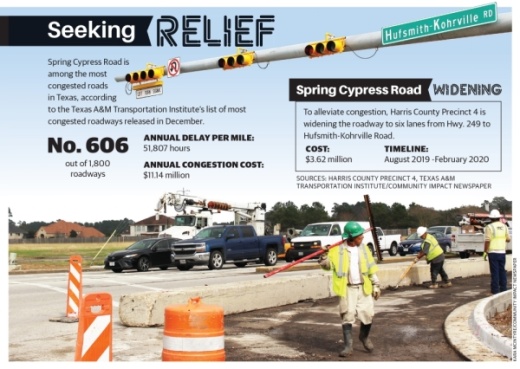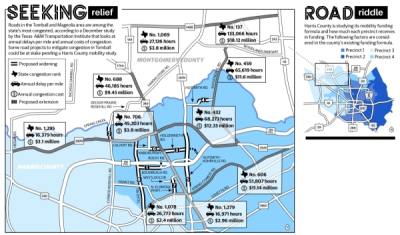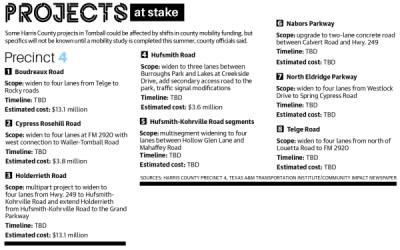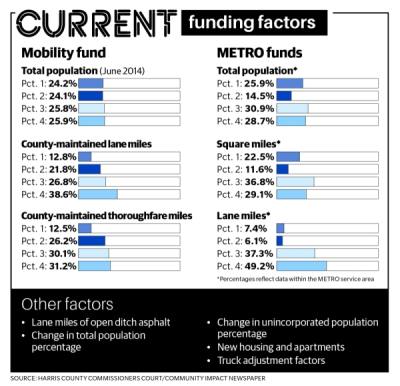Ten stretches of roadways in the Tomball and Magnolia area—including FM 1488, FM 2920, and Spring Cypress and Kuykendahl roads—ranked in the TTI’s list of the more than 1,800 most congested roadways in Texas released Dec. 10.
Funding for some transportation projects planned to address some of those roadways—including the widenings of Holderrieth Road, North Eldridge Parkway and Hufsmith-Kohrville Road—could be in question following a Harris County shift in mobility funding last summer that left Precinct 4 with less mobility funding.
This could mean delayed traffic relief for Tomball-area drivers if those projects can no longer be completed as originally planned, said Pamela Rocchi, the director of Precinct 4’s capital improvement projects division, in an email.
“The projects Precinct 4 has identified and pursued were based on previously approved funding allocations,” Rocchi said in the email. “Shifting funding away from Precinct 4 can impact the scheduling of currently active projects and push uninitiated projects further into the future.”
A Harris County study analyzing the life expectancy and condition of every county-maintained road, launched in July, is set to be complete this summer. However, county officials said they plan to make some funding recommendations in February.
Colleen Gilbert, the chair of the Greater Tomball Area Chamber of Commerce’s Government and Legislative Affairs Committee, said she worries road project delays in Precinct 4 could hurt businesses in the area.
“People are looking for the ability to get to work and the ability to get to their restaurants and shopping options. You’ve got to have your roadways and your structures there,” she said. “We’re in the middle of so many [road] projects right now, and I’m afraid of the path we’re going down ... that a lot of [Precinct 4] will be overlooked.”
Studying Harris County roads
The Harris County mobility study launched in July with a 4-1 vote, with Precinct 4 Commissioner Jack Cagle dissenting, after commissioners voted to evenly split the sales tax revenue the county receives from the Metropolitan Transit Authority of Harris County in June. Previously, Precinct 4 received 33% of sales tax revenue.Precinct 1 Commissioner Rodney Ellis said he wants the study to improve upon the previous system, which he said he believes was arbitrary and unfair to precincts 1 and 2.
“It’s a fair way to do this until we figure out some way of doing it that takes into account a review of where the money has gone in the past with an eye towards equity—fairness to people who normally get overlooked,” Ellis said at the July meeting when the funds were shifted.
However, both Cagle and Precinct 3 Commissioner Steve Radack have expressed concerns about the study’s potential outcomes.
Cagle said he fears the study could be used as a “power play” to divert funds from precincts 3 and 4 under the guise of improving efficiency.
“We’ll have to wait and see what occurs with regard to the raw grab of money,” Cagle said in a Nov. 20 interview. “If the raw grab of money occurs, then we’re going to have problems in terms of how we take care of the responsibilities that we need to take care of.”
Rocchi said 11 projects in the Greater Tomball area are early enough in the planning stages that funding could be affected, including the widening of Boudreaux Road from Telge to Rocky roads, the widening of North Eldridge Parkway from Spring Cypress Road to Westlock Drive, the widening of Holderrieth from Hwy. 249 to Hufsmith-Kohrville, and the extension of Holderrieth from Hufsmith-Kohrville to the Grand Parkway.
However, she said projects in the later stages of design—such as the widening of Hufsmith-Kohrville from Hollow Glen Lane to Ezekiel Road and the upgrades to Hufsmith Road from Burroughs Park to Lakes at Creekside Drive—are less likely to be affected by shifts in precinct mobility funding.
“A reduction of funding could delay a project from moving into design or construction, which would result in a cascading effect of delays among all subsequent projects,” Rocchi said.
When the engineering department presents the mobility study to commissioners in February, Harris County Engineer John Blount—whose department is leading the study—said the presentation will include recommendations for how funds should be split and direction from commissioners on what factors should be taken into account when prioritizing projects.
Under the current mobility and METRO funding formulas, factors such as total county-maintained lane miles, total county-maintained thoroughfare miles and the total population of each precinct are taken into consideration when splitting the funds, according to Commissioners Court data. Precinct 4 maintains the highest percentages of total county-maintained lane and thoroughfare miles of the precincts, totaling 38.64% and 31.23% respectively.
Money from several different sources is at stake, including roughly $120 million in toll road funds, $30 million in METRO funds and $390 million in unspent funds from a 2015 Harris County mobility bond.
“Each commissioner has their own idea in their mind about what factors are most important,” Blount said.
Most congested roadways
While funding is at stake for some Precinct 4 projects, the widening of Spring Cypress Road—which landed as the 606th most congested roadway in Texas—from Hwy. 249 to Hufsmith-Kohrville is scheduled to be complete in February. TTI uses a combination of factors, such as the time spent in traffic and wasted fuel from sitting in traffic, to determine the rankings, according to TTI information.“The rapid growth of residential and commercial development along Spring Cypress Road has led to an increase in congestion along the corridor,” Rocchi said.
Roads in Montgomery County also made TTI’s list, including FM 1488 from FM 2978 to I-45. This portion saw a daily traffic volume of 54,333 vehicles in 2019 and ranked the 137th most congested roadway, up from No. 201 in 2018, TTI data indicates.
To help reduce congestion, the Texas Department of Transportation’s access management study of the corridor from FM 149 to I-45 is expected to conclude in late spring, Public Information Officer Emily Black said. The study outlines proposed safety and mobility improvements that could be implemented in the short and long term, such as new traffic signals, Community Impact Newspaper previously reported.
Parts of FM 2920 between Hegar and Kuykendahl roads also moved up the list of the most congested roadways from 2018-19, including one section from Hwy. 249 to Kuykendahl, which moved from No. 564 in 2018 to No. 432 in 2019.
To gather public input on a proposed widening, TxDOT hosted an open house Jan. 28 in Tomball. The project—for which a cost and timeline has not been released—would widen FM 2920 between Business 290 and Hwy. 249.
Local concerns
While TxDOT has proposed road projects to help alleviate congestion l•ocally, Harris County Precinct 4 projects are still at stake until the mobility study is completed, Rocchi said in an email.Both Cagle and Radack have expressed concerns about their precincts losing money. In an interview following the study’s launch, Radack pointed to the amount of funds each precinct currently spends on mobility projects as evidence the needs are greater in precincts 3 and 4.
According to budget data, an estimated $103 million in unspent mobility funds was carried over from 2018 to 2019 in Precinct 1 compared to $45 million in Precinct 4. With rollover funds and new allocations combined, Precinct 1 started 2019 with $125 million in the bank, compared to $81 million in Precinct 4.
The higher spending may be related to the portion of those precincts that fall within unincorporated Harris County, Radack said.
Gilbert said she believes having the METRO funds divided into quarters is unfair, as 72% of Precinct 4 lies in unincorporated Harris County and roads are primarily maintained with county funds.
“We don’t have other funding [in Precinct 4]. We only have two cities ... and those make up such a minuscule portion of the precinct, so the rest of the roads are county roads,” Gilbert said. “Splitting the funding evenly may seem fair on the surface, but it’s really not.”








